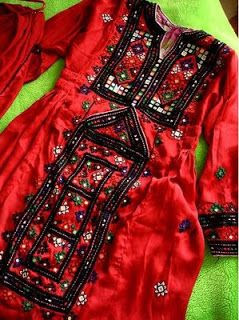The clothing of Baloch is distinguished by colorful
embroidery patterns that serve as cultural symbols, helping to differentiate
Baloch from rest of the cultures and people in the world. Balochi dresses
especially with attractive embroidery have long been the pride and the cultural
beauty of Baloch.
 Most characteristic of Baloch costume is
embroidery of a beauty and intricacy that contrast strongly with the simplicity
of the rest of Balochi material culture. The designs, of which there are many,
are composed primarily of geometric shapes such as that of flowers and leaves
arranged in regular patterns. Of course, Baloch women’s dresses provide the
best examples of such colorful and careful handwork; the colors of embroideries
are beautifully animated with beautiful and colorful patterns. Certain specific
embroidery patterns are very common across Balochistan such as mirchuk, and zuratto with six or seven colors. Use of a
single pattern is most common though sometimes more than one are combined on a
single garment.
Most characteristic of Baloch costume is
embroidery of a beauty and intricacy that contrast strongly with the simplicity
of the rest of Balochi material culture. The designs, of which there are many,
are composed primarily of geometric shapes such as that of flowers and leaves
arranged in regular patterns. Of course, Baloch women’s dresses provide the
best examples of such colorful and careful handwork; the colors of embroideries
are beautifully animated with beautiful and colorful patterns. Certain specific
embroidery patterns are very common across Balochistan such as mirchuk, and zuratto with six or seven colors. Use of a
single pattern is most common though sometimes more than one are combined on a
single garment.
Moreover, one of the most popular embroidery works is the
“frame design”, in which decorations or flowers (pull), of
complex shape, some complete (tik) and others truncated (kapp), which
are then filled in with different colors, each of which has its specific place
in the design. Among them Kappuk and Panchuly or Murge
Panch are the most common
embroidery specifically in Makran.
In some pieces of embroidery only thread in a huge amount
of colors is used, whereas in others small circular mirrors (shishag)
are also incorporated into the designs such as Jalar-o-naal and Pariwal-e-tik or Pariwal-e-naal.
Among the Baloch such work is part of an ancient tradition, in which small
pieces of mica were used before thin mirror glass became available. The
designs with mirrors incorporated are very common across Balochistan.
Most Baloch women know how to embroider, and take interest
in such work. They do not use charts or diagrams but instead create extremely
complex designs from memory, often with assistance and suggestions from the
elderly members of the family or neighbors. Little girls begin to learn basic
stitches and patterns at about the age of six or seven years.
Many women sit aside a few hours after completing their
daily household works for embroidery work in the afternoons or in the evening,
either alone or in groups. Straight needles and thread are most commonly used
though hooked needles are required for some patterns. Once the embroidery is
finished, the garment is assembled by a local tailor or by the woman herself if
she is fortunate enough to own a sewing machine. Making clothes fulfills the
important needs of family; extremely skilled embroiderers or those, who are
quite poor, may also sell their work to other community members. The prices for
their work are considerably depending on the difficulty of the pattern and
other factors. Also, most women work for years embroidering fine works of art
for their sons and daughters’ dowries (jahaz,).
Embroidering clothes provides much enjoyment and
recreation for women, who take great pride in their handiwork and consider it
the essence of being Baloch. No doubt, some new Balochi embroideries are said
to be given baseless names, which don’t seem to be that much civilized;
however, what encourages is the embroidery technique which remains the same and
reflects the cultural beauty of Baloch.
Hello Bahram,
ReplyDeleteI was just reading your article about Balochi Embroider and trust me you have mentioned really well about Balochi Culture.
Balochi Embroidery is always fascinating and gives a traditional though stylish look. There is a lot of work being done in past couple of years and designers are specializing in it.
This comment has been removed by the author.
DeletePlease Recommend some reasonable website or any other source from which it could be bought.
ReplyDelete